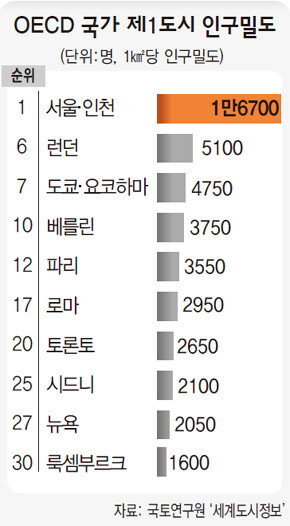hankyoreh
Links to other country sites 다른 나라 사이트 링크
Seoul ranks highest in population density among OECD countries

Statistics from an urban research institute Web site show that population density in Seoul is the highest among large cities in the advanced nations belonging to the Organisation for Economic Co-operation and Development (OECD). Observers say this underscores the urgency South Korea faces to redistribute its population outside the capital through a balanced regional development policy. The report indicates that Seoul is a super-dense city with a population concentration two to ten times greater than other major cities located within OECD nations. The statistics also indicate that other cities with similar popular densities are for the most part located in developing nations with far lower income levels than South Korea.
On Monday, researchers affiliated with the Hankyoreh analyzed statistics presented by the “Urban Information Network,” a Web site affiliated with the Korea Research Institute for Human Settlements. According to these figures, the population density for the Seoul metropolitan area that includes the nearby area of Incheon, amounted to 16,700 persons per square kilometer, the highest among the largest cities found in the 30 OECD nations. The density is even higher for the city of Seoul by itself, with 17,219 persons per square kilometer. This is twice the density of 8,400 persons per square kilometer in the second-ranked city, Mexico City, and more than ten times higher than Luxembourg, the lowest-ranked city.
It is also roughly eight times the population density of both New York City (2,050) and Sydney (2,100), five times that of Rome (2,950), four times that of both Paris (3,550) and Berlin (3,750), and three times that of Tokyo-Yokohama (4,750) and London (5,100).
Seoul also ranked seventh for population density among 43 megacities with populations of 5 million people or more. The cities with higher per kilometer population density than Seoul are all in developing nations, namely Dhaka, Bangladesh (132,550), Mumbai (29,650) and Kalkota (23,900), Karachi (18,900), Lagos (18,150), and Shenzhen, China (17,150). The cities ranking immediately below Seoul are Taipei(15,200), Chennai (14,350), and Bogota (13,500). Twelve of the 43 cities with 5 million inhabitants or more are located in OECD countries, but Seoul is the only one ranked in the top twenty for population density. Among the top 30, three other cities in OECD nations, namely Mexico City at 24th, Istanbul at 27th, and the Osaka-Kobe-Kyoto metropolitan area in Japan at 30th join Seoul. The remainder fall outside of the top 30.
The Urban Information Network website also includes rankings for the 50 cities with the highest quality of life for 2009 as selected by the consulting company Mercer. The top-ranked cities were, in order, Vienna, Zurich, Geneva, with Vancouver and Auckland in a tie for fourth place. All 50 were cities in OECD countries, and no South Korean cities were included on the list.
Gang Yong-sik, president emeritus at Hanbat University and a member of the Joint Civil Society-Government Task Force to Revise the Sejong City Development Plan, says, “Seoul is losing its competitiveness because its population is murderously high in comparison with other OECD nations.” Gang added, “Dispersing the population outside of the capital through balanced development is the way not only for the provinces to survive but for Seoul as well.”
In a 2006 report, the OECD remarked on the need for Seoul to relieve its population density for the sake of maintaining its competitiveness.
Please direct questions or comments to [englishhani@hani.co.kr]
Editorial・opinion
![[Column] Has Korea, too, crossed the Rubicon on China? [Column] Has Korea, too, crossed the Rubicon on China?](https://flexible.img.hani.co.kr/flexible/normal/500/300/imgdb/original/2024/0419/9317135153409185.jpg) [Column] Has Korea, too, crossed the Rubicon on China?
[Column] Has Korea, too, crossed the Rubicon on China?![[Correspondent’s column] In Japan’s alliance with US, echoes of its past alliances with UK [Correspondent’s column] In Japan’s alliance with US, echoes of its past alliances with UK](https://flexible.img.hani.co.kr/flexible/normal/500/300/imgdb/original/2024/0419/2317135166563519.jpg) [Correspondent’s column] In Japan’s alliance with US, echoes of its past alliances with UK
[Correspondent’s column] In Japan’s alliance with US, echoes of its past alliances with UK- [Editorial] Does Yoon think the Korean public is wrong?
- [Editorial] As it bolsters its alliance with US, Japan must be accountable for past
- [Guest essay] Amending the Constitution is Yoon’s key to leaving office in public’s good graces
- [Editorial] 10 years on, lessons of Sewol tragedy must never be forgotten
- [Column] A death blow to Korea’s prosecutor politics
- [Correspondent’s column] The US and the end of Japanese pacifism
- [Guest essay] How Korea turned its trainee doctors into monsters
- [Guest essay] As someone who helped forge Seoul-Moscow ties, their status today troubles me
Most viewed articles
- 1[Column] The clock is ticking for Korea’s first lady
- 2[Correspondent’s column] In Japan’s alliance with US, echoes of its past alliances with UK
- 3Samsung barricades office as unionized workers strike for better conditions
- 4After 2 months of delayed, denied medical care, Koreans worry worst may be yet to come
- 5[Column] Has Korea, too, crossed the Rubicon on China?
- 6[Editorial] When the choice is kids or career, Korea will never overcome birth rate woes
- 7Hong Se-hwa, voice for tolerance whose memoir of exile touched a chord, dies at 76
- 8US overtakes China as Korea’s top export market, prompting trade sanction jitters
- 9Constitutional Court rules to disband left-wing Unified Progressive Party
- 10Nearly 1 in 5 N. Korean defectors say they regret coming to S. Korea